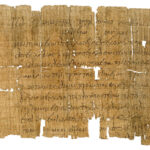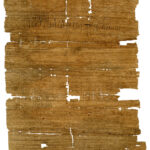| Artefact ID | 523 |
| TM ID | TM 33557 |
| Findspot (DEChriM ID) | 55 (Qarāra) | Class | Textual |
| Material | Papyrus |
| Writing medium | Sheet/roll |
| Text content | Documentary |
| Language | Greek |
| Archive/Dossier | Archive |
| Description | P.Neph. 3: Letter from Paulos to Nepheros. Letter of apology addressed to "our most revered and beloved father Nepheros" from Paulos who informs him that he has not yet been able to get the oil he was apparently supposed to send do Nepheros. As an excuse, he explains that he had to take care of his children (maybe his wife Tapiam was already gone on her journey from Alexandria unless she has died from her illness (see P.Neph. 1). Also, he has sent to him "our brother" Horion, a monk from the monastery (mone) in Akyron (see SB VIII 9683), with some commodity whose nature is lost. Mention of one Taese, possible a nun (see P.Neph. 5). The provision of oil is one of the constant orders Paulos receives from the monastery. The editors note that, according to the small quantities involved, the oil was probably to serve cultic purposes or reserved for the use of the higher dignitaries (rather than for cooking). But why was the oil sent from Alexandria rather than from the surrounding area? They suggest that it was the finest oil that was looked for and that it first had to be consecrated by the bishop for ritual purposes.
Recto: script written in a professional and "latinate hand" that could be dated much later without context; names of recipient and sender are artistically spaced. No elaborate Christian greetings; no diacritics and no nomina sacra (Bagnall 2018: 91). Text runs parallel with the fibres. Verso: address, along the fibres. |
| Selection criteria | Christian terms/formulas/concepts, Christian onomastics |
| Date from | 350 |
| Date to | 370 |
| Dating criteria | Palaeography, archive connection and historic context led the editors to suggest a range of date around 360 for the Nepheros correspondence (Kramer and Shelton 1987: 5). According to the study of the prices mentioned in the archive, Bagnall 1989: 75 (= BL IX, 173) suggests a range after 352. |
| Absolute/relative date | Relative date |
| Archaeological context | The P.Neph. were bought on the market but according to the seller they were all found together. Nothing in the archive led the editors to doubt this statement and they add that the archive were probably found in the direct vicinity of the ancient location of the monastery of Phathor (see Kramer and Shelton 1987: 5). |
| Accession number | Heidelberg, Institut für Papyrologie P.Heid. Inv. G 2142 |
ARTEFACT IDENTIFIERS
Editio princeps
• Kramer, Bärbel and John. C. Shelton (ed.). 1987. Das Archiv des Nepheros und verwandte Texte. Part I, Das Archiv des Nepheros. Aegyptiaca Treverensia IV. Mainz, no.
Additional bibliography
• Bagnall, Roger. 2018. "The Educational and Cultural Background of Egyptian Monks." In Monastic Education in Late Antiquity. The Transformation of Classical Paideia, edited by L. Larsen and S. Rubenson. Cambridge: Cambridge University Press, 75-100.
• Bagnall, Roger. 1989. "Dating the archive of Nepheros. " In "Fourth-Century Prices: New Evidence and Further Thoughts." Zeitschrift für Papyrologie und Epigraphik 76, 69-76 (esp. 75).
• Choat, Malcolm. 2017. "Monastic Letters on Papyrus from Late Antique Egypt." In Writing and Communication in Early Egyptian Monasticism, edited by M. Choat and M. Ch. Giorda. Leiden-Boston: Brill, 17-72 (esp. 25-29).
• Wipszycka, Ewa. 2009. Moines et communautés monastiques en Egypte (IVe – VIIIe siècles). Journal of Juristic Papyrology Suppl. 11. Warsaw, 81-82.


 Json data
Json data





